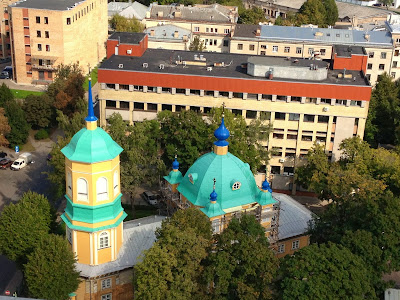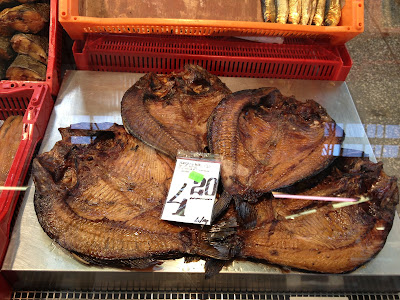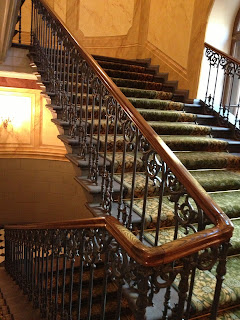The Latvian Academy of Sciences Building and the Maskavas District
The area of Riga that extends beyond the Central Market -- known as the Maskavas Forštate (Moscow District) -- is more interesting than one would immediately guess, and it took me a year of living here in Riga to discover it. Most of it is in poor shape, but there is lots of history and culture hidden here, if you know where to look.
The main landmark of this area is the Latvian Academy of Sciences Building, built in the Stalinist style over a period from 1951 to 1961.
 |
| The Latvian Academy of Sciences Building |
The building is similar to many others erected during the Stalinist period in the Soviet Union and in other parts of Eastern Europe, including the Seven Sisters in Moscow, the Hotel Družba in Prague, the Hotel Ukrayina in Kiev, and others. And my Polish friends noted the similarities with the Palace of Culture in Warsaw.
 |
| The Facade of the Latvian Academy of Sciences |
The Soviet symbols have been largely removed from this structure, except for some hammers and sickles at the very top that are hard to detect. Instead, the Latvians have reclaimed this building for themselves and, as they renovate it, they are emphasizing its links to Latvia. The building was designed by Latvian architects and decorated by Latvian craftsmen, and their art is evident in many big and small details, such as the oak leaf cluster motif throughout (from the facade to the light fixtures), and a wood and glass door that reminded me of the Arts and Crafts style.
 |
| A Chandelier |
 |
| A beautiful door |
But, most importantly, this building houses Latvian culture, arts, and science. And for that to remain as is, everything must change…. The hammers and sickles decorating the halls have been replaced by the Latvian symbol of learning: an owl crowned by three stars representing the three historical regions of the country (Vidzeme, Latgale and Kurzeme-Zemgale).
One of the tallest building in Riga, the Latvian Academy of Sciences offers among the best views of the city -- especially because, unlike the tower of St. Peter's, it affords a view of the spires of this church as well. Buy a ticket to the viewing platform (available from a kiosk in the lobby) and ride the elevator to the 17th floor, and you will see this:
 |
| Riga in September from the Latvian Academy of Sciences |
The opposite side of the viewing platform shows a different view: a collection of old buildings from different time periods in need of renovation; some green areas and a few empty lots; and here and there a few onion-shaped domes of different colors. This is the Maskavas Forštate side of the city and the area where Russians and Jews settled in earlier centuries.
 |
| The Maskavas District of Riga |
The green areas and empty lots are sadly what remains of the center of Riga's Jewish community before World War II. The Great Choral Synagogue stood in this area, until it was burned down in 1941 with a large contingent of the Jewish population inside. A memorial is located on the site of the Synagogue at the corner of Gogoļa and Dzirnavu streets.
The onion-shaped domes testify to the Russian origins of the Maskavas district. The distant green dome in the picture above belongs to the Russian Orthodox Church of All Saints, while the golden dome in the picture below belongs to an Old Believers church, also knows as Grebenshikov's Church. This is one of the largest Old Believers congregations in the world and I have heard it houses a remarkable collection of icons. These are two very interesting attributes, so I've tried to go visit this church many times, but I can never seem to find it. I saw it clearly once from the train as it crossed the Daugava River on the way to the Central Station, and later I drove around the area where I thought I saw it -- but no luck. From above, though, the golden dome is unmistakeable -- and maybe one day I'll make it there.
 |
| The Golden Dome of the Old Believers Church |
And then, if you look straight down from the top of the Latvian Academy of Sciences building, you will see this:
 |
| Church of the Annunciation of Our Most Holy Lady |
This is the Russian Orthodox Church of the Annunciation of Our Most Holy Lady. What is notable about this, you will ask, apart from the vibrant colors? Well… this is where the Sicilian writer Giuseppe Tomasi di Lampedusa married the Latvian psychoanalyst Alexandra Wolff von Stomersee in 1932.
Wow! The Leopard here in Riga!! I ran down to see the church up close. It's small, and like many Orthodox churches it's both cozy and opulent inside. It's being renovated and it looks beautiful, maybe even better than it did in 1932, but it probably mostly stayed the same, while around it the world changed.
 |
| A Glimpse of the Church through the Gate |
















































